There’s nothing like an ear of sweet corn, picked fresh from your own garden just moments ago. And you can absolutely succeed with corn in the backyard, if you consider these 6 tips:
- Choose an appropriate variety
- Proper planning and site conditions
- Understand corn pollination
- Plant in blocks
- Hand pollinate
- Protect from suburban wildlife
6 Tips for Growing Corn in Small Spaces
1. Choose an appropriate variety
Selective breeding has made several different types of sweet corn available to the home gardener. The wikipedia entry has a great table summarizing them. The one important thing for people with gardening neighbors to keep in mind, is that “super sweet” corn (bred to maintain its incredible sweetness and texture for weeks) will be ruined if it is cross pollinated with other types of corn. The kernels will be tough and starchy. So grow it at least 25 feet away from other types of corn, or time your planting so that it will tassel at least 10 days before or 10 days after other corn planted nearby.
2. Proper planning and site conditions
All of the same rules for growing corn on large scale apply to a small backyard patch.
- Full sun exposure (the more, the better)
- Good, rich garden soil with plenty of compost and adequate moisture
- Warm soil temperature (at least 65 degrees F) before sowing seeds, because germination is poor in cool soil. Here in MA, a good rule of thumb is 1-2 weekend after Memorial Day weekend.
- Awareness of garden pests and a plan for management
3. Understand corn pollination
Each kernel on an ear of corn corresponds to one thread of “silk”, the female reproductive organ. The kernel does not develop unless its corresponding thread of silk is pollinated. A poorly pollinated ear of corn will be small, with a lot of space between the kernels.
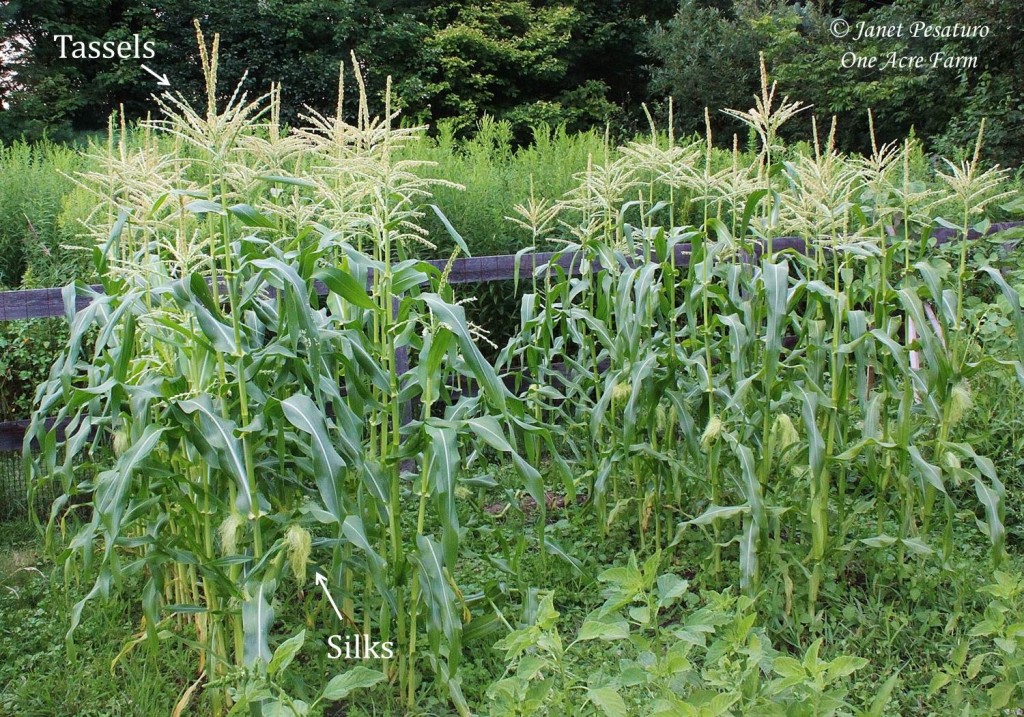
6 Tips for Growing Corn in Small Spaces. Block planting, as in this photo, illustrates one of these tips.
For the kernel to be pollinated, pollen grains from the anthers (those little rice like things attached to the tassels) must make contact with the silk. This happens naturally when wind blows anthers and pollen dust into the silks. Thus, we say that corn is pollinated by wind rather than insects.
4. Plant in blocks
Because it is pollinated by wind, a corn plant needs to be close to other corn plants to be fully pollinated. A corn plant that is surrounded by many other corn plants, is likely to be successfully pollinated, because pollen can come at it from all directions. So here’s the take home point:
- A single long row of corn is a poor configuration.
- A big circle or square (block planting) is best. The photo above is an example of how we do it: Four 10-foot long rows, spaced 2-3 feet apart, with about 10-15 plants in each row. It’s basically a 10 x 10 ft square patch.
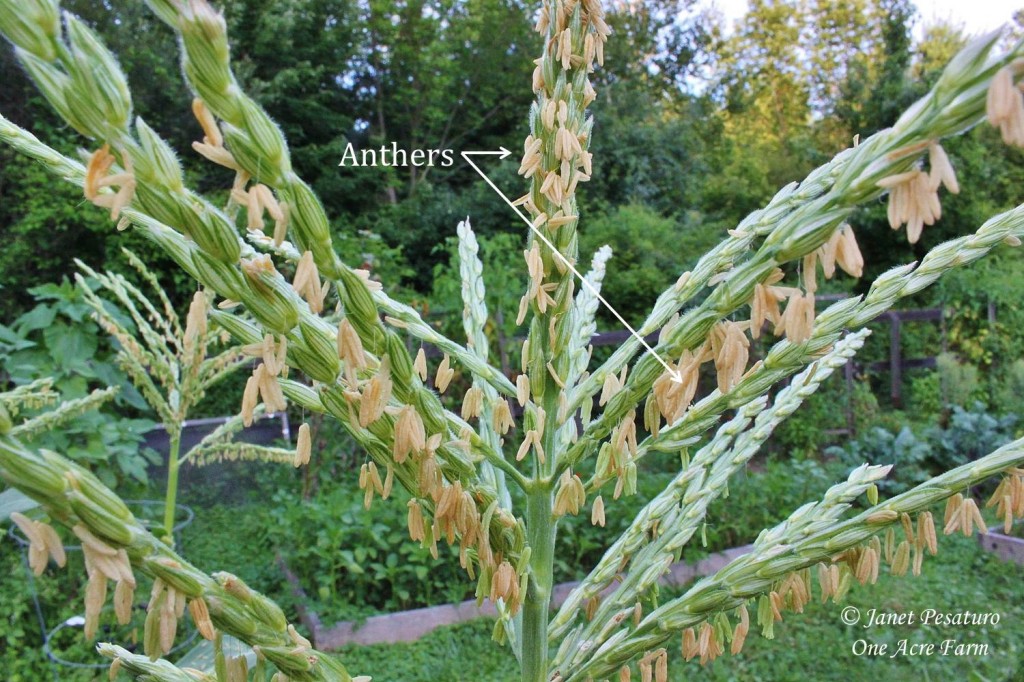
6 Tips for Growing Corn in Small Spaces. It’s important to understand corn pollination. This is a photo of the tassels of one corn plant, with anthers labelled. Anthers produce the pollen grains.
5. Hand pollinate
Block planting helps, but if your block is really small, pollination will not be optimal, because there just isn’t a lot of pollen around to reach the silks. So don’t depend entirely on the wind. Hand pollinate.
How to hand pollinate
This is the easiest of garden tasks. Don’t make it any more complicated than it has to be. The first source I consulted on hand pollinating corn advised collecting the anthers in a paper bag, and then carefully sprinkling them on the silks. Even more complicated, another one said to cut off the tassels and use a paint brush to pick up the pollen from the tassels and apply it to the silks.
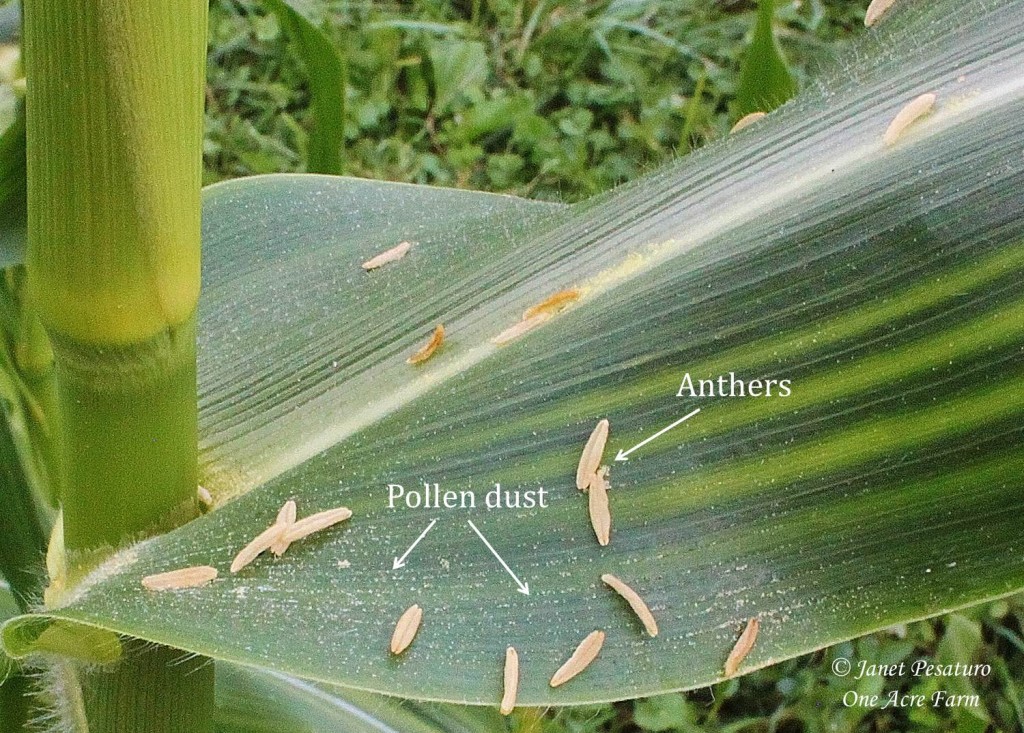
6 Tips for Growing Corn in Small Spaces. Understanding corn pollination is part of it. This photo shows the anthers and pollen grains.
Totally unnecessary. No need to make a production out of this. If I had to remember to bring a paper bag or clippers and paint brush out to the garden, I would never get around to hand pollinating. All you really need for this simple task is your hand and your brain. Here’s what to do:
- Run your fingers along the length of a tassel, allowing anthers and pollen grains (yellowish dust) to fall into the palm of your hand.
- Sprinkle the anthers and dust onto the silks of an ear of corn on a different plant (corn is not self-fertile, which means it must be cross pollinated).
- Pollen can be placed anywhere along the length of the silk for pollination to occur.
- Even easier is to simply shake the stalks so that the pollen falls from the anthers and down to the silks. However, the success of this is still somewhat dependent on the wind, so if you’ve remembered to take both your hand and your brain out to the garden, use the method above. It’s just as easy.
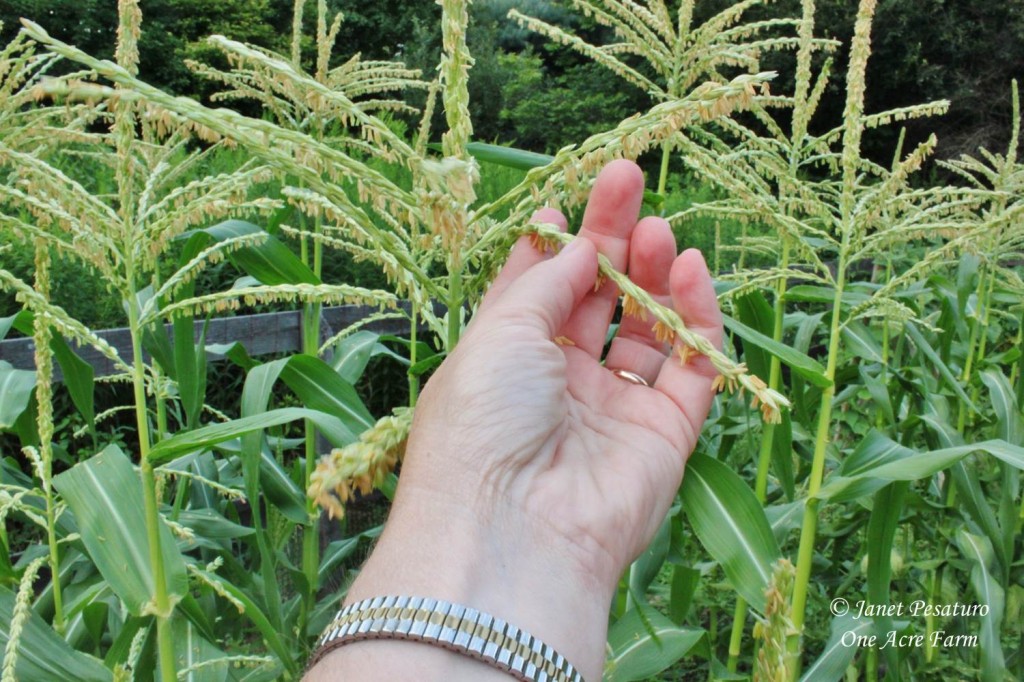
6 Tips for Growing Corn in Small Spaces. Hand pollinating is easy, and helps develop ears of corn full of plump kernels.
When to hand pollinate
Tassels and silks emerge from an ear of corn at around the same time. The tassels shed most of their pollen within about a week of emergence of the anthers, and silks are receptive to germination for about a week after they emerge.
- Hand pollinate once a day for about a week after emergence of anthers and silks. The silks begin to turn brown after pollination, so you will know when to stop.
- Do it only during dry weather, because anthers do not shed pollen when wet.
- Time of day does not matter much, as long as you don’t do it when the corn is wet, or just before it rains.
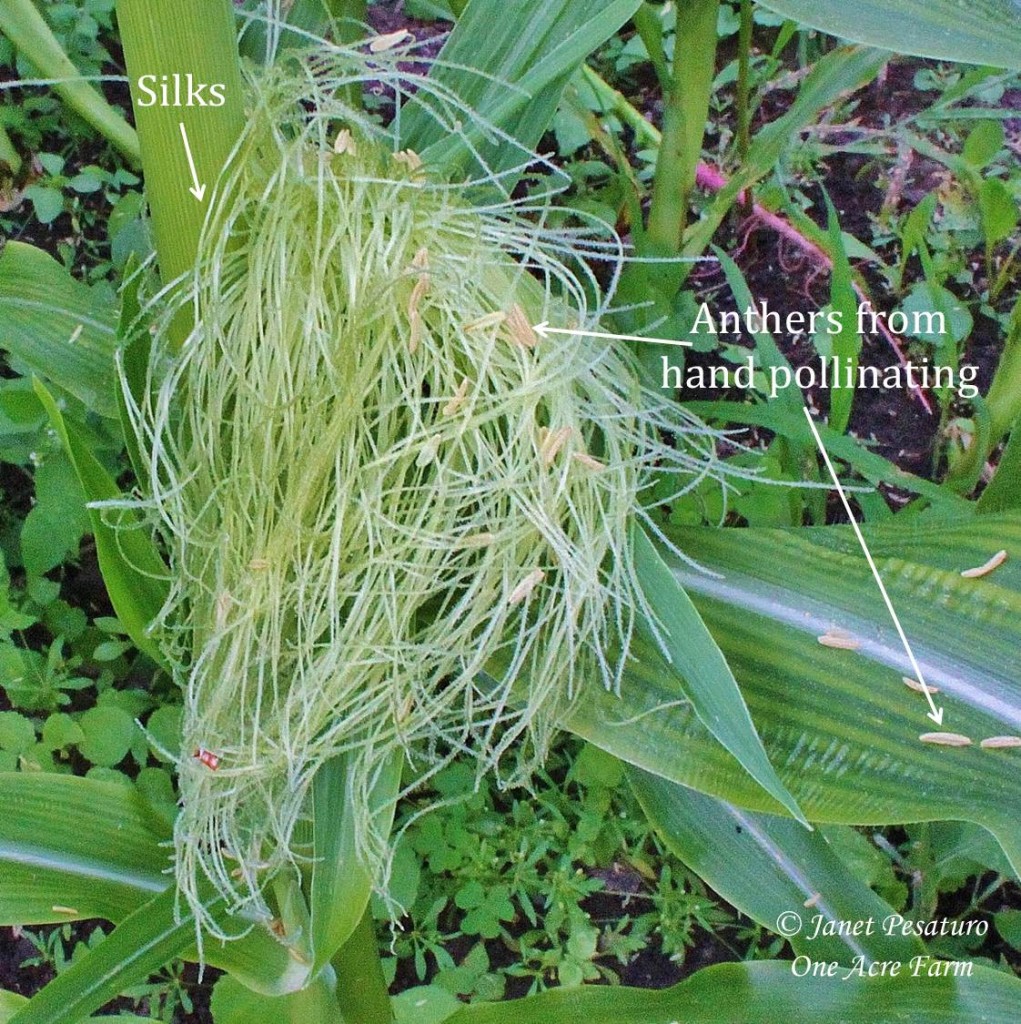
6 Tips for Growing Corn in Small Spaces. Hand pollinating is one important tip. This photo shows the silks with anthers after hand pollinating.
Which plants to hand pollinate
It’s most important to hand pollinate the corn that’s growing around the periphery of your block. That is because they are not exposed to pollen from all directions. So if you don’t have time to do them all, just focus on the ones at the edges.
6. Protect from wildlife
Consider protecting your corn patch with an electric fence, because humans are not the only animals that like sweet corn.
- Bears love it, and can cause great damage, but don’t usually live in the denser suburbs.
- Coyotes might pull down a few stalks to munch on developing ears, but usually do not do a lot of damage.
- Raccoons are the biggest threat to corn in suburban areas. They sometimes come in family groups and pull down a lot of stalks.
We have plenty of raccoons here, but they devastated our little patch only once or twice in our 15+ years of growing corn. We just chalked it up to the cost (among many benefits) of sharing the land with wildlife, and did nothing about it. If it happens again, we’ll go for that electronetting.
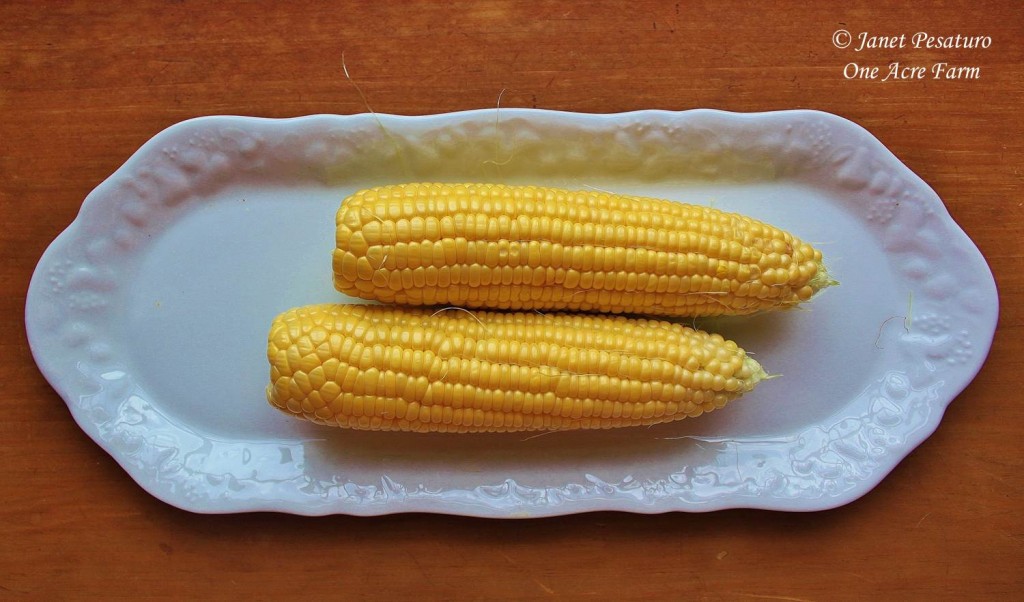
6 Tips for Growing Corn in Small Spaces. Using these tips, most of our corn looks just like these two ears: Full of sweet, plump kernels!
Sources:
Shared on: Farmgirl Friday #160, Simply Natural Saturday, Heritage Homesteaders Hop #15, Wonderful Wednesday Blog Hop #82, Homestead Barn Hop #169











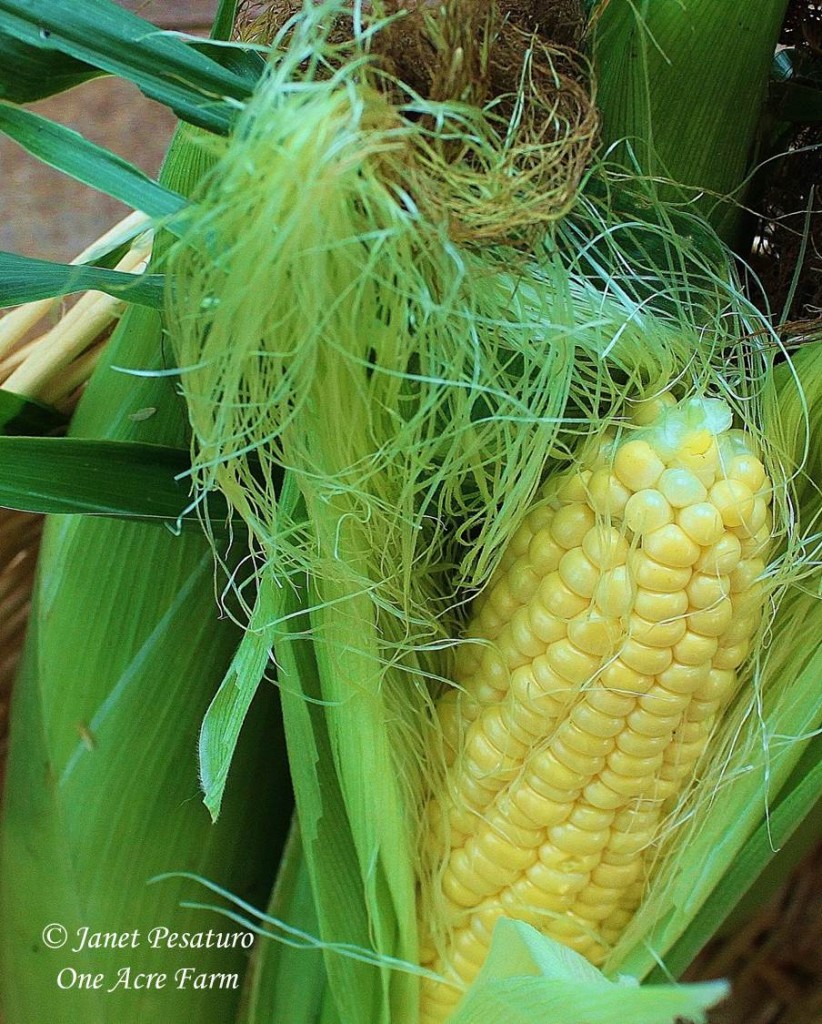
Thanks for the great advice! We tried corn a couple years ago with absolutely no luck. I wanted to try again this year and I think this might make the difference!
Good luck, Christina!!
In town another concern is the squirrels! We lost our whole crop to squirrels. Sneaking things came in from the back, didn’t make much of a mess the first time so we didn’t notice. The next day it was like a tornado had hit! We are not growing corn this year but if we do next year it will be fenced and guarded! Thanks for all the great tips!
Oh! Good point! Now that I think of it, we have had gray squirrels munch on the corn from time to time, but they didn’t do a lot all at once, so we didn’t lose much to them. Here, they don’t go after it until it is ripe, at which point we just pick it all. An advantage to supersweet is that it stays sweet in the fridge for much longer, so you don’t have to eat or freeze everything you pick all at once. Raccoons, on the other hand, destroyed the whole patch in one night.
Im also plagued by squirrels to. Needless to say,come small game season,i try my best to thin out the local population.
Ive also had issues with earwigs chewing the tassles off before being pollinated.
Great post! I tried corn last year and found myself stymied. Okay … so maybe I WILL try again. Thanks for this!
Thanks, Jo. I hope you do try it again!
This is probably a dumb question but I am originally a city gal. I want to know what a typical yield is? Your block planting recommendation would take about half of my total garden and I am wondering if the amount of corn I would get would make it worth it.
Not dumb at all. Yield depends somewhat on exactly which variety of corn you choose. Some varieties, usually the taller ones, get 2 or even 3 good ears per stalk. I grow supersweet because it stays sweet and tender while sitting on the stalk or in the fridge for much longer, but usually we get only 1 large ear per stalk, and often a 2nd smaller one. So in our 10 x 10 foot block, we get at least 40 large ears and a bunch of small ones. (We give the little ones to the chickens)
If you hand pollinate, you can grow a much smaller patch of corn. If your garden is really small, you could plant one little group of one stalk in the middle, surrounded by 4-6 additional stalks. Since you wouldn’t have much to store, you don’t need to go with supersweet. You could look for taller varieties of standard sweet corn that more reliably get 2-3 large ears. Your soil would need to be really fertile to get that yield, though. I think my husband’s uncle got 3 ears per stalk from Silver Queen, which is a standard variety that grows 8-9 feet tall.
Great response. Thanks for the detail about a “really small” space. I’m planning to do a guild planting as a demo in a street side patch of my condo garden this year and wanted to include some corn,
With your detail on how to plant and hand pollinate, I think it just might work!
Thanks for this great information! I planted corn this year for the first time, and some of the ears were good, others not so great! I chose the Silver Queen variety that I got at the local co-op. I cannot wait to try it again and give a little assist with pollination on the next go around!
Thanks for writing, Patti. I hope you try the hand pollination, and that it works well for you!
Thank you for this information! I’m new to the gardening idea, and I planted my corn all in one row. Now I at least have a chance to make it productive. Next year, I’ll plant in the block. Thank you for sharing your knowledge!
Good luck, Anita!
We’ve had very little success with corn in our backyard garden. I’m pinning for next year – hopefully these tips will chance our outcome.
I hope you meet with success next year, Ginger. Good luck!
Thank you for this post. My garden sits on a 1/2 acre homestead in the city. I would love to plant corn but every time I try it gets destroyed by squirrels or never seemed to grow. I think I’m going to try hand pollination, maybe that will help with the not growing part. Now I just have to figure out how to keep the squirrels out.
Good luck, Kimberly, I hope you figure out how to keep the squirrels away. They are small, but I guess they’re persistent enough to do damage on corn in some areas.
HI!! You might try planting in a cloche or greenhouse, in containers… hand pollinate, and allow to complete growth in the greenhouse, or enclose in wire netting, with a plastic roof…use unwanted or damaged CD disks or pieces of aluminum foil to deter the animal invaders. HAPPY GARDENING !!
Pingback: How to Start a Backyard Farm - One Acre Farm
Pingback: My First Attempt at Growing ANYTHING
This information is wonderful! Do you recommend starting with seeds vs. plants?
how to deal with corn worms.?? names of sweet corn.. do you pollinate when the silk shows ??
Hi Don, I’ve never had problems with corn worms, so I can’t help you with that. Yes, I pollinate when the silk shows, and continue pollinating about once a day until silk begins to turn brown. It’s usually just a few days. I’ve used several varieties of super sweet corn. I can’t recall the names, but I get my corn seeds from Johnny’s Selected Seeds.
Some great tips…will certainly try to improve my success with suggestions this summmer…thanks
Glad you found it useful, Mike. Good luck with your garden!
I love your instructions they’re easy to understand and seem easy to do. There is one thing I’d like to ask. Due to physical limitations I can no longer do a full garden. Will this work if I use containers placed close together and do the hand pollution?
Hi Ann, yes, you can certainly grow them in containers and hand pollinate them. I’m glad the article was helpful!
Pingback: A Few Random Facts | My Michigan Homestead
Hi,could you PLEASE do a pic by pic…step by step of the hand pollination? Or do a short 5 min youtube video? I need to SEE how its done! Thanks if you can. Regards,kevin
Read the section on “how to hand pollinate” and look at the 5th and 6th photos in this post. There is really nothing more to it than that.
Hello! I live in Philly and this is my first time planting corn. Just so I’m clear on what you said, if I had one plant it would not yield anything b/c they don’t self pollinate, I’d have to have at least two, correct? I have 4 plants and 2 have 3 “soon to be ears” and the other 2 have 2. Another question I have is do you have to fertilize? I’m asking because I didn’t, the ground was never opened up so this is the first planting and it seems ok. It seems to be flourishing! Just making sure. Thanks for this info. I’ve read and seen other “how to hand pollinate corn” stuff and they make it SUPER complicated!!
I think it can pollinate itself, but the chance that sufficient pollen will reach the silks to produce a full ear of corn are low if there is only one plant. I believe you can hand pollinate the from the anthers of one plant to the silks of the same plant and get full ears.
Whether or not you need to fertilize depends on your soil. If soil is very rich at the start, you will probably get a good yield with no additional fertilizer. I usually do add compost or manure tea, or mulch with dirty hay from my chicken runs at some point during the growing season, though. I got my best yield when I watered with alpaca manure tea periodically through June and July, after mulching in spring with poopy hay from the chicken runs.
Janet I am a new comer…I live near Stafford CT. I also have a lovely area of garden fruit trees berries and herb garden. I had a beautiful “Butter and Sugar” corn patch this year, 12′ by 8′, we picked over 60 ears the first time we picked. However there were quite a few smaller ones not quite yet ripe so we left them on to continue to ripen. We can out one morning and found that our garden fence had been torn down and pickets scattered everywhere. Our corn patch was completely ruined. We had a black bear! Now I am frightened to even go out and pick tomatoes or anything from my garden. Do you have any advise on how to keep black bears from your yard and garden? Thank you for all the useful information.
Electric wires along the fence are a good way to deter bears. They are very strong, as you discovered, and can tear apart most fencing. They are also good climbers and diggers. See my post on predator proofing chicken coops and runs, where I describe our electric fencing. Same idea.
Love your common sense, simple approach to this!I am growing Chires corn for the first time this year, and hope the same theory applies! I have read a lot about corn getting weaker every year if you save seed…and you must plant a lot to do this well…so may hand pollinating will help?
Hm, I hadn’t heard that corn gets weaker each year if you save seed. And what exactly does that mean? That germination rate will be lower each year?? Whatever it means, I doubt hand pollinating will help. That just ensures that more kernels will develop. It does not make them “stronger” than kernels pollinated by wind.
I plant corn every year and have the same problem every year. It grows, makes ears that are not filled out, then the rain and wind come and knock over ever stalk! After reading your I now know about the pollination and how to get it done. I don’t how to deal with the wind and rain. Here in Mississippi, we just deal with what we have at hand. Thanks for your article. I intend to follow your posts from here on out.
Thank you very much for the advise! I had horrible issues last year which was my first year trying. I had fire ants take over the cobs. If you peeled open the husk the ants poured out. I now think that pollination was so poor that the cobs stopped growing and started to rot which attracted the ants. I knew I was ignorant to growing corn but now I know how ignorant I was 🙂
Every year, mine will get blown over during a storm. It seems to be the combination of the rain making it top heavy, then the wind is the final blow (pun intended). It does not straighten up on its own and trying to straighten and tie it back up creates even more damage. The only thing I haven’t tried is planting it in a square between posts and then criss-crossing ropes throughout the patch and raising the level as the corn grows.
We run a fence of hardware cloth around the corn and greenbeans part of our garden. In addition, we run 2 strands of hot wire…one about 6 inches from the ground for rabbits and raccoons, the other about 4 inches above the hardware cloth for the squirrels. In addition, we ensure that nothing tall is near enough to the fence to be a jumping off point for the squirrels. Onion, garlic, radishes, lettuce, potatoes, etc. are ok, but peppers and eggplant are too tall.
Thanks for the tips you have given. I am going to try it when the rains comes.
I planted my small patch of sweet corn in a raised bed planter in our front yard. I planted one planting of 6×3 plants every two weeks. I planted the seeds in a bucket then transplanted to the bed after the seedlings were several inches high. I used worm castings for compost and so far have fertilized twice with bone Meal, blood meal and a third mixture containing the remaining essential nutrients. Looks like tassels are appearing on the first group. Will try your hand fertilizing techniques and get back to you with a followup report!
Many of my stalks have “babies “(smaller stalks) coming out at their base. Should I remove these to keep from weakening the main stalks?
in the smaller urban areas( which we live in ), it becomes impossible to rotate crops. Im doing fine with planting my lettuce in the same place year after year just as long as I add a lot of organic matter. but what about corn? not too many places in a small garden to rotate. Do you think that would be a problem if planted in the same square area year after year?
Thanks for your great advice! From Will 8 years old.
Thank you for writing such an informative article. I’m eager to use your suggestions on hand pollinating. I stumbled across your blog via google and plan to peruse the rest of your articles now!
thanks for the helpful advice!
Living in a rural setting, wildlife is a real problem. Gardening for me is a hobby. Hobbies cost money. To protect my garden from wildlife, I enclosed the entire garden in 1 inch poultry wire, sides and top. If you decide to go this route make it tall enough to house the corn, 10+ feet. Now all you need to worry about is disease, small rodents, and insects. Happy gardening.
You state that corn is not self pollenating, but other sources say it is self-fertil I’m confused which is it?. I always wait until soil is warm 70 degrees or more, I sow in deep furrows at least 6″ deep but only cover with 2″ of soil and hill-up the stalks as they grow, finally reaching a hill height of 6 or 8″ above the garden level, new roots will sprout at the joints and help keep the stalks from tipping over in wind storms, but only to a point. I always isolate by 600 yards or more or space at least 4 weeks between tasseling for succession planting If my neighbor grows corn I share seed with him so we both sow the same variety. If the soil is too dry at sowing time, I run a quick stream of water down the furrow just to make it wet, before sowing too much and to cold of temps will rot the seed.
It’s been a long time since I researched corn pollination, but to answer your question I just spent a few minutes looking into it again. I don’t have an authoritative source on it, but on the internet there is conflicting information on that. Just to be on the safe side, I use pollinate the silks of one stalk with the tassel of another.